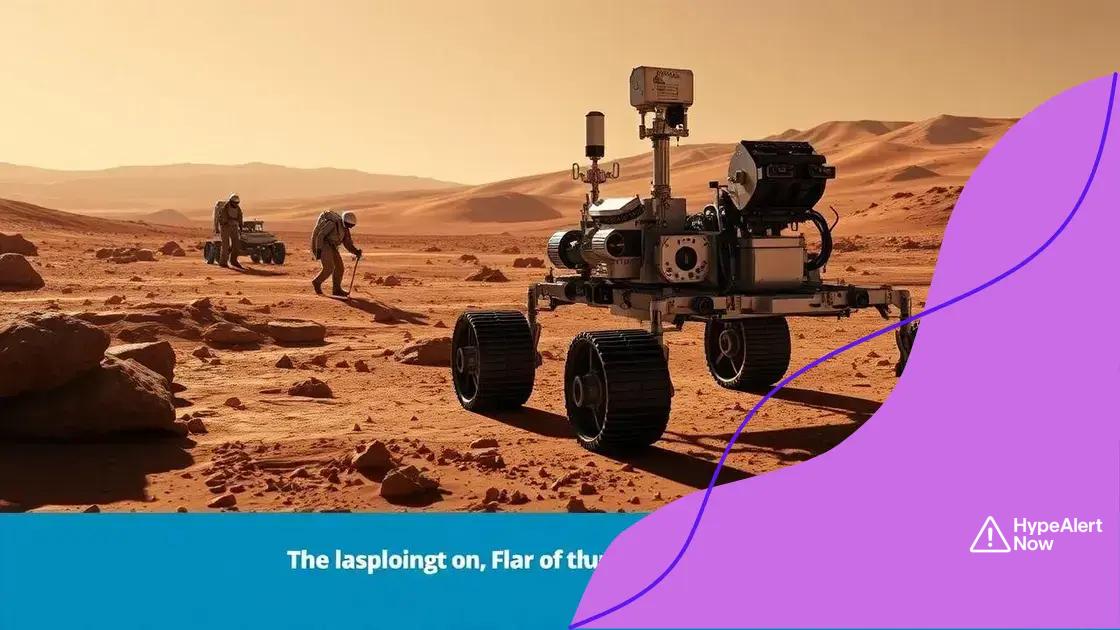Recent milestones in American space programs

Recent milestones in American space programs include NASA’s successful Mars rover landings, advancements in reusable rocket technology by the private sector, and ongoing international collaborations enhancing research and exploration efforts.
Recent milestones in American space programs show how far we’ve come in our quest to explore the cosmos. Have you ever wondered what breakthroughs NASA and private companies have achieved lately? Let’s dive in!
Key achievements of NASA in recent years
In recent years, NASA has achieved remarkable milestones that have reshaped our understanding of space. From launching new missions to developing innovative technologies, NASA continues to push the boundaries of exploration.
Notable Missions and Discoveries
One of the most significant achievements was the successful landing of the Perseverance rover on Mars in February 2021. Its mission focuses on searching for signs of ancient life and collecting samples for future return. The James Webb Space Telescope, launched in December 2021, promises to deepen our knowledge of the universe by providing unprecedented views of distant galaxies.
Technological Innovations
NASA has also made headway in developing new technologies that enhance space missions. These innovations include:
- Advancements in rocket propulsion systems to improve launch capabilities.
- New spacecraft designed for crewed missions to the Moon and Mars.
- Cutting-edge robotic systems to aid scientific exploration.
These advancements not only assist in ongoing missions but also pave the way for future innovations in space travel and exploration.
Education and outreach programs have seen an expansion as well. NASA’s programs aim to inspire the next generation of scientists and engineers. By engaging students through interactive experiences, NASA ensures that the spirit of exploration continues to thrive.
Collaborations for Greater Impact
Finally, NASA has strengthened its collaborations with international partners. These partnerships allow for shared knowledge and resources, enhancing the impact of joint missions. Countries across the globe contribute to space exploration, creating a united effort to push the frontiers of knowledge.
With these key achievements, NASA stands at the forefront of space exploration. As it continues to evolve, the agency aims to unlock the mysteries of the universe while inspiring future generations.
The role of private sector in space exploration
The role of the private sector in space exploration has grown significantly in recent years. Companies like SpaceX, Blue Origin, and Virgin Galactic are transforming the landscape of how we think about space travel and exploration.
Innovative Launch Services
Private companies have developed cost-effective launch services, making space more accessible than ever. For example, SpaceX’s Falcon 9 rocket has drastically reduced launch costs, allowing more frequent missions. This evolution supports both governmental and commercial ventures.
Collaborative Missions
Private industry partners with NASA on missions, sharing expertise and resources. The Commercial Crew Program, for instance, allows SpaceX and Boeing to transport astronauts to the International Space Station. This collaboration enhances safety and improves mission success rates.
Furthermore, private companies are venturing beyond Earth’s orbit. Innovations such as advanced spacecraft and lunar landers are being developed to support missions to the Moon and Mars.
Driving Technological Advances
The private sector’s involvement drives technological advancements that can benefit humanity. Initiatives like asteroid mining and space tourism open new frontiers in science and commerce. These projects spark public interest in space and inspire future generations.
Moreover, startups focused on satellite technology improve global communications and data collection. Companies are also exploring developments in space-based solar power, which could revolutionize energy production.
As private firms continue to invest in space exploration, we can expect exciting developments. Their innovative approach complements governmental efforts, paving the way for a new era in space travel.
Future missions planned for Mars

Future missions planned for Mars are exciting endeavors that promise to expand our knowledge of the Red Planet. Various space agencies and private companies are gearing up for exploration efforts that may unveil the mysteries of Mars and its potential for human exploration.
NASA’s Artemis Program
NASA’s Artemis program aims to return humans to the Moon as a stepping stone for Mars. This program supports technology tests and practices for future human missions to Mars, focusing on the lunar surface’s challenges.
Human Exploration Plans
Human missions to Mars are being explored with a target for the 2030s. NASA plans to send astronauts to Mars, aiming to conduct research and establish the possibility of life on the planet. These missions will involve:
- Training astronauts in extreme environments.
- Utilizing advanced life support systems.
- Developing habitats for long-duration stays.
- Learning about Mars’ climate and geology.
With these preparations, scientists hope to gather crucial data that can inform future colonization efforts.
International Collaborations
Global partnerships are essential for Mars exploration. Agencies like the European Space Agency (ESA) and India’s ISRO are working with NASA on various Mars projects. These collaborations enhance research and increase mission success through shared technology and resources.
Upcoming missions also include robotic landers and rovers designed to study Mars’ atmosphere and surface. These advanced missions will help identify resources like water and assess potential landing sites for human explorers.
The goal is to create a sustainable presence on Mars, paving the way for eventual colonization and the search for extraterrestrial life. Future missions will not only inform our understanding of Mars but also provide insights into the broader universe.
Technological advancements in rocket designs
Technological advancements in rocket designs have revolutionized space travel. Today, rockets are more efficient, powerful, and affordable than ever before. These innovations play a crucial role in expanding our capabilities for exploration and satellite deployment.
Reusable Rockets
One major advancement is the development of reusable rockets. Companies like SpaceX have pioneered this technology, allowing rockets to land safely back on Earth after delivering payloads to space. This reduces costs and increases the frequency of launches.
- SpaceX’s Falcon 9 can be reused multiple times.
- This cuts down the expenses associated with each launch.
- Reusable technology opens doors for more ambitious missions.
By reusing rocket components, space agencies can redirect funds to research and development for future missions.
Innovative Propulsion Systems
Advancements in propulsion systems are another critical area of improvement. New technologies such as ion propulsion and liquid oxygen/kerosene engines improve efficiency and performance. These systems have the potential to increase travel speed and reduce fuel consumption, making missions more feasible.
With these new propulsion methods, scientists can explore distant planets with less risk and greater precision, which is especially important for missions to Mars and beyond.
3D Printing in Rocket Manufacturing
Another exciting development is the use of 3D printing in the manufacturing of rocket parts. This technology allows engineers to create complex components rapidly and at a lower cost. 3D printing contributes to lighter designs, which lead to improved fuel efficiency.
The ability to print parts on-demand means that supplies can be produced closer to launch locations, further streamlining the process.
Technological advancements in rocket designs continue to change the future of space exploration. Innovations make it possible to dream bigger and aim higher, paving the way for the next generation of explorers.
International collaborations in space research
International collaborations in space research play a crucial role in advancing our understanding of the universe. Countries around the world are joining forces to tackle complex challenges in space exploration, leading to groundbreaking discoveries.
Joint Missions and Projects
One of the best examples of international collaboration is the International Space Station (ISS). The ISS brings together space agencies like NASA, ESA, Roscosmos, JAXA, and CSA. Together, they conduct experiments in microgravity that benefit science and humanity.
Sharing Resources and Expertise
Collaborative efforts allow countries to share resources and expertise, leading to more efficient and cost-effective missions. For instance, the Mars Rover missions often involve teams of scientists from different nations. They work together to analyze data and share findings, which enhances our understanding of the Martian environment.
- Joint training programs for astronauts.
- Shared technology and equipment for missions.
- Co-developed spacecraft, such as the Orion capsule.
These partnerships create a strong network that fosters innovation and ingenuity.
Global Scientific Community
Collaborations extend beyond government agencies. The global scientific community actively engages in sharing knowledge and findings through conferences, journals, and online platforms. Scientists from various countries collaborate on experiments, pooling their expertise to solve common challenges.
Such teamwork encourages diversity in research approaches and enhances the quality of scientific inquiries. Working together, scientists can conduct broad studies that wouldn’t be possible alone, leading to more robust conclusions.
Future Collaborations
Looking to the future, international collaboration will continue to grow. Upcoming missions to Mars and beyond will likely involve multiple nations partnering to expand human presence in space. These efforts will not only bring nations together but also inspire future generations to engage in space science and exploration.
The future of space exploration shines brightly with numerous advancements and collaborations. As countries work together, technologies improve, making exploration more efficient and engaging for future generations. With each mission, we not only enhance our understanding of the universe but also inspire young minds to dream big. The journey continues, with every launch bringing us closer to uncovering the mysteries of space.
FAQ – Frequently Asked Questions about Recent Milestones in American Space Programs
What are some of the recent milestones achieved by NASA?
NASA has successfully landed the Perseverance rover on Mars and launched the James Webb Space Telescope, expanding our understanding of space.
How is the private sector contributing to space exploration?
Private companies like SpaceX and Blue Origin are developing reusable rockets, drastically lowering launch costs and enabling more frequent missions.
What is the significance of international collaborations in space research?
International collaborations enhance research by pooling resources and expertise, allowing for more comprehensive studies and joint missions.
What future missions are planned for Mars exploration?
Future missions include sending humans to Mars in the 2030s, along with advanced robotic missions to study the planet’s geology and atmosphere.
